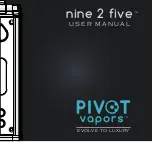
WT.050.200.001.UA.IM.0814
50-200 EVAPORATOR FOR CHLORINE
42
EVOQUA
W3T98237
WARNING: TO AVOID SEVERE PERSONAL INJURY DUE TO INHALATION
OF CHLORINE, USE AN APPROVED GAS MASK AND VENTILATION
EQUIP MENT WHEN REMOVING THE RUPTURE DISC.
CAUTION: When installing rupture disc, ensure that the groove of the disc
fits the mating tongue of safety head to avoid altering the operating level of
the rupture disc.
Refer to 50.202.007.011. The expansion chamber is isolated from the chlo-
rine by the rupture disc (10). Since the expansion chamber is not exposed to
chlorine under normal conditions no preventative maintenance is required
for the expansion chamber. The expansion chamber has a pressure switch (5)
attached to it to monitor the chamber’s internal pressure. The pressure switch
(5) is preset to 20 psi at the factory. During initial start up this switch should
be tested prior to installing the rupture disc (10) into the safety head union.
4.12 “In-Place” Cleaning of the Evaporator Cylinder
The rate of residue buildup varies considerably with the type of impurity, the
source of chlorine supply, the rate of usage, and various other factors. The
following maintenance cleaning procedure should be implemented every 12
months, or sooner if a loss in superheat or reduction in chlorine capacity is
observed. These instructions describe a method for cleaning chlorine residue
from the evaporator without removing the cylinder. The special accessories
required by this procedure for cleaning and drying are available in kit form in
Evoqua Water Technologies Part No. W3T109990. The replacement gaskets
required for each evaporator are included in parts kit W3T110050. A water
supply line of 3/4-inch pipe size at a minimum pressure of 20 psi must be
available. The hose required is not furnished as part of either kit. If these
instructions are carefully followed, the cylinder should be clean and dry when
restored in service.
In some circumstances, it could be desirable to thoroughly review the relative
advantages of cleaning versus simply replacing the evaporator cylinder, thereby
eliminating the time and necessary complexities of the cleaning process and
enjoying the security and full operating capacity provided by a new cylinder.
This choice would take into consideration the local cost and availability of
personnel, facilities, equipment, and time required for the cleaning process
measured against the installed cost of a new cylinder. This comparison can be
made only on the basis of individual local circumstances.
Under normal operating conditions, deposits will accumulate in the evaporator
cylinder and, over a period of time, will reduce its operating capacity. For this
reason, periodic cleaning is required to remove these deposits.
CAUTION: Refer to the instruction book provided with the equipment for
complete details on recommended frequency and procedures to properly
accomplish this cleaning.
!
!
!
Summary of Contents for Wallace&Tiernan 50-200 Series
Page 1: ...Series 50 200 Evaporator For Chlorine BOOK NO WT 050 200 001 UA IM 0814 W3T198237 ...
Page 2: ...SERIES 50 200 EVAPORATOR FOR CHLORINE BOOK NO WT 050 200 001 UA IM 0814 W3T198237 ...
Page 15: ...WT 050 200 001 UA IM 0814 50 200 EVAPORATOR FOR CHLORINE 4 EVOQUA W3T98237 ...
Page 75: ...WT 050 200 001 UA IM 0814 50 200 EVAPORATOR FOR CHLORINE 64 EVOQUA W3T98237 ...
Page 95: ...CHLORINE HANDLING MANUAL Cl2 BOOK NO WT 025 000 001 UA IM 0614 W3T98244 ...







































